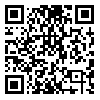Volume 22, Issue 3 (11-2020)
yafte 2020, 22(3): 118-129 |
Back to browse issues page
Department of Biomedical Engineering, Science and Research Branch, Islamic Azad University, Tehran, Iran
Abstract: (2077 Views)
Background: Keratoconus is a common complication among corneal defects. As a result of expeditious and extensive progress of medical science in recent decades, corneal ring implantation has turned into a successful surgical procedure to correct the vision of Keratoconus patients; however, selecting the right patient is essential in the success of the operation. The prediction of corneal condition or, more precisely, the prediction of corneal topographic indices after implanting the ring has been taken into consideration in the present study.
Materials and Methods: Neural network framework is one of the optimal methods for the modeling and prediction. In this study, corneal topographic indices of patients have been predicted 6 and 12 months after the ring implantation for the first time using the multilayer feed forward neural network. The study has focused on predicting corneal topographic indices that are applicable to Keratoconus diagnosis and progression using MATLAB software. Therefore, the statistical data of a number of patients, including the effective indices of the cornea topography before and after implanting the ring, were collected.
Results: Using the collected data, neural network models have been developed and the corneal topographic indices have been predicted 6 and 12 months after the implantation of keraring and myoring rings. The mean error of 7.22% is achieved for the four trained neural network models.
Conclusion: Choosing the right surgical candidate is one of the primary concerns of ophthalmologists. The results indicate the great capability of neural networks in assisting ophthalmologists to select right surgical candidates through predicting corneal topographic indices after the ring implantation.
Materials and Methods: Neural network framework is one of the optimal methods for the modeling and prediction. In this study, corneal topographic indices of patients have been predicted 6 and 12 months after the ring implantation for the first time using the multilayer feed forward neural network. The study has focused on predicting corneal topographic indices that are applicable to Keratoconus diagnosis and progression using MATLAB software. Therefore, the statistical data of a number of patients, including the effective indices of the cornea topography before and after implanting the ring, were collected.
Results: Using the collected data, neural network models have been developed and the corneal topographic indices have been predicted 6 and 12 months after the implantation of keraring and myoring rings. The mean error of 7.22% is achieved for the four trained neural network models.
Conclusion: Choosing the right surgical candidate is one of the primary concerns of ophthalmologists. The results indicate the great capability of neural networks in assisting ophthalmologists to select right surgical candidates through predicting corneal topographic indices after the ring implantation.
Type of Study: Research |
Subject:
چشم
Received: 2020/02/15 | Accepted: 2020/06/23 | Published: 2020/12/16
Received: 2020/02/15 | Accepted: 2020/06/23 | Published: 2020/12/16
| Rights and permissions | |
 |
This work is licensed under a Creative Commons Attribution-NonCommercial 4.0 International License. |



